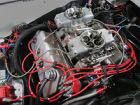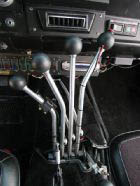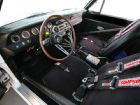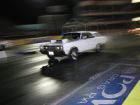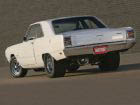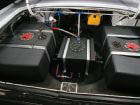
Can You Really Call Something That Runs 9s With A Lenco, A Tunnel-Ram, And Dual Four-Barrels A Street
Car? You Bet Your Sweet Heinie.
By: Stephen Kim
Photography by: Stephen Kim
Reprint from www.hotrod.com
Riding shotgun in Gary Powell’s ’69 Dart is pure sensory overload your brain can hardly handle. At 7,000 rpm, the 528-inch Hemi spits out an indignant rasp of sonic booms through the tailpipes, as if challenging Satan to a duel. In the background, the staccato clack-clack-clack of the Lenco summons subtle changes in the motor’s pitch, as a series of billet shift levers, activation rods, and Heim joints clutchlessly engage successive cogs. Meanwhile, the Hemi’s 900-plus horses pull tremendously, the Dart’s back end skates precariously at triple-digit speeds, and the fading spec in the mirror is a 9-second Camaro. It all goes down in a matter of seconds, and this sort of intensity is what over-the-top hot rodding is all about.
Upon first glance, it’s difficult to accurately assess the Dart’s true purpose. Other than a somewhat garish hoodscoop, it doesn’t look all that different from your typical street machine. Take a few steps closer, however, and the dual 850-cfm carbs glinting inside the scoop give a visual tease to what’s really going down under the hood. The twin double-pumpers are attached to a tunnel-ram that feeds a 798hp Indy Cylinder Head crate motor. Inside, things get a bit more interesting, with a slew of goodies that hints at a modicum of roadworthiness. There’s a full interior, A/C, a stereo, a Gear Vendors overdrive, and even a cupholder for Gary’s coffee mug. Furthermore, bolted inside the trunk are three fuel cells-two 16-gallon units for normal driving and one 2-gallon enrichment cell for when Gary cracks open the 150hp shot of spray. All this hardware makes for a hefty 4,000-pound race weight that belies the A-Body’s compact dimensions. With such an eclectic mix of contradicting components, the big question is, what exactly is this car all about? Is it a race car, a street car, or just another high-dollar poseur?
Gary swears he drives his car at least four times a week, informs us that it’s been on several Power Tour(r) Long Hauls, and claims it should run high 9s at the track. It’s all too similar to lines we’ve heard countless times in the past, so we made him prove his claims during a weekend of both legal and not-so-legal drag racing. Despite having never before run this particular combo at the track, the Dart laid down an impressive 9.90 pass at 137 mph on a 1.48 60-foot at the Texas Motorplex during a Friday night test and tune. There’s definitely more to be had, as the Dart struggled to find the ideal medium between bog and spin off the line all night, and a post-race inspection revealed two melted spark plugs.
After the track closed, we cruised all over town looking for some action at the usual Dallas/Fort Worth hot spots. Other than the nitrous’d 502 Camaro the Dart quickly disposed of, the crowds were thin this particular evening. However, the miles we logged revealed how surprisingly well mannered such an extreme combination can be, which is partly attributable to a relatively mild Comp 248/254-at-0.050 solid roller cam. The Hemi didn’t spit, sputter, buck, surge, or display any of the malevolent inclinations that usually plague motors pushing close to 1,000 hp. Likewise, the Lenco isn’t as much of a bear to manhandle as folklore would tend to suggest. “Everyone says you can’t run a big solid roller, a tunnel-ram, dual quads, and a Lenco on the street, but I say, ‘Why not?'” Gary quips. “The Lenco freewheels in First through Fourth gear when you get off the gas, which makes it very friendly to operate on the street. That means since there is no engine braking, you don’t have to step on the clutch all the time when you’re coasting to a stop.”
As is often the case, the impetus for building such a wild street brawler was getting involved with the wrong crowd. “All of my friends have big-block Chevelles and Camaros, and I used to try to cruise with them in my ’65 Dart convertible,” Gary recollects. “They’d smoke me so badly that I had to call them on my cell phone to find out where they were to catch up. I figured it was time to put an end to that nonsense, which is when I decided to build this car.” Perhaps the reason the Dart runs like a race car at the track is because it used to be a race car. When Gary purchased it, the Dart was equipped with a 440 and a TorqueFlite trans and ran 10.30s in the quarter. His plan was to convert it back into a street car and build a ’69 Hemi Dart Super Stock clone. Reinstalling the interior, glass, bumpers, inner wheelwells, lights, sound-deadening material, and steel fenders and hood added 700 pounds of weight.
To complete the clonification, Gary dumped the 440 in favor of a Mopar Performance 528 crate Hemi. After a while, its 600 hp wasn’t enough, so he upgraded to the current Indy motor. Unfortunately, the TorqueFlite didn’t take too kindly to the additional 200 hp. “Immediately after installing the Indy 528, the TorqueFlite burned up high-gear clutch packs every two weeks,” Gary says. “This prompted the adaptation of a virtually bulletproof Lenco trans and a Gear Vendors overdrive unit that had to be custom-fitted into place. Of course, this comes as a nasty surprise to twin-turbo Vipers and crotch rockets. They expect the Dart to run out of mph on the top end, but it doesn’t.”
The glory comes with a price, however, and any motor that puts out this kind of power is going to require getting your hands dirty. The Hemi likes eating through spark plugs, and the solid lifter cam mandates periodic valve lash adjustments. Furthermore, so much power, grip, and weight have managed to rip the shock mounts right off the rearend in the past. Nonetheless, Gary revels in the hands-on disposition of the Dart. “Even though it’s really radical, I’m very happy with how the car turned out,” he explains. “The maintenance keeps you involved with the car, and working on it is half of the enjoyment of owning it. The other half is driving the snot out of it. I have a 45-minute commute and drive it into work at least once a week, even when it’s 110 degrees outside.”
Granted, there’s absolutely nothing about this car that’s grassroots or budget oriented, but that isn’t the point-so quit your whining. Over-the-top rodding isn’t about spending your bucks efficiently or building your car in a fashion that every schmuck can emulate. It can be about wretched excess and taking things to the extreme just because you can. And how much more extreme can you get than a Hemi-powered, tunnel-ram’d, Lenco-shifted Dart that runs 9s and cruises on the freeway in Overdrive with the air-conditioning on?
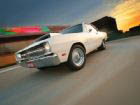
The fiberglass Super Stock-style scoop Gary originally installed on the car dislodged itself at 125 mph. He built a replacement out of 1/4-inch aluminum stock.
Quick Inspection: ’69 Dodge DartGary Powell * Frisco, TXPowertrainEngine: Rat-bashing power comes courtesy of an Indy Cylinder Head 528ci Street Legend crate Hemi. Accommodating the massive 4.500-inch bore is a Mopar mega-block, which encases a Callies 4.155-inch forged crank, Eagle 6.860-inch steel rods, and Wiseco 10.0:1 pistons. A custom Comp 248/254-at-0.050 solid roller cam with 0.604/0.591-inch lift, Isky lifters, and Indy 1.6:1 shaft-mount rockers manage the valve events. Up top, ported Indy 426-1 aluminum heads with 2.25/1.94-inch valves, an Indy tunnel-ram intake manifold, and dual Barry Grant 850-cfm carbs provide plenty of flow to spin the Hemi happily to 7,600 rpm on special occasions. The distributor, plug wires, two-step rev limiter, and ignition box are all from MSD. Exhaust exits through a set of custom 21/2-inch long-tube headers built by Joe Smith Racecars, a custom H-pipe, and dual 3-inch Flowmaster mufflers. An NOS Big Shot nitrous system adds another 150 hp.
Power: On the pump, the Hemi kicks out 798 hp at 6,700 rpm and 795 lb-ft at 5,200 rpm in naturally aspirated trim. The combo has never been dyno’d with the nitrous activated.
Transmission:Slick clutchless shifts are executed via a Lenco ST-1200 five-speed mated to a Lakewood bellhousing and a McLeod twin-disc clutch and flywheel. The tranny’s ratios were custom-selected to optimize the Hemi’s powerband. A Gear Vendors overdrive unit allows chugging around town at a relaxed 0.75:1 ratio. It’s all held in place by a custom crossmember built by Joe Smith Racecars (Dallas, Texas). International Truck built the custom 22-inch steel driveshaft with U-joints out of a dump truck.
Rearend: Enduring inclement clutch dumps is a Dana 60 rearend that’s fortified with a Strange spool, 40-spline axles, and 4.10:1 gears.
ChassisFrame: Custom subframe connectors and a six-point rollbar stiffen up the chassis and keep the tech inspectors happy, at least for now. The trans tunnel has been modified to make room for the Lenco trans.
Suspension: Up front is a Reilly Motorports tubular K-member and control arms, and QA1 coilovers. In the rear, Calvert Racing traction bars and leaf springs, Monroe shocks, and a PST 11/4-inch sway bar help put the power down.
Brakes: Reilly Motorsports 14-inch front discs with Baer pads and factory rear drums shed speed. Smoky burnouts come courtesy of a Hurst line-lock kit.
Wheels: The Dart rolls on Cragar S/S wheels that measure 15×8 up front and 15×10 in the rear.
Tires: Mickey Thompson 29.5x 11.5-15 ET Drags provide the hook, and Toyo 225/50-15 Proxes steer it down the track. For street use, the Mickey Thompson 315/50-15 ET Street radials work surprisingly well, given the Hemi’s stout output.
StyleBody: To fit the big meats, the back end has been minitubbed. Gary built the Super Stock-style scoop himself out of 1/4-inch aluminum. A donor car shed its rocker panels, hood, trunk, and doors to convert the Dart back into road-worthy condition.
Paint: A1 Paint and Body (Dallas, Texas) sprayed the car in DuPont White.
Interior: The back seats have been removed, and the front buckets are out of a ’70 Challenger. Occupants are held in place by Simpson five-point harnesses. A custom dash insert, which was built by Gary, houses a set of Auto Meter gauges. Creature comforts include a Vintage Air A/C system and an Alpine stereo.
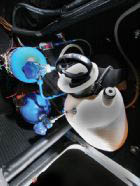
Mounted in front of a pair of 10-pound nitrous bottles, where the back seat used to be, is a trick VHT system Gary rigged up himself. It’s built from a plastic garden sprayer, filled with VHT, and pumped up to 20-25 psi of pressure. A valve stem on the bottle hooks up to a brass ball valve through a hose, which Gary can open and close from the driver seat. The hose then routes directly behind the front tires and lays down a 16-inch-wide pattern of VHT. He says it really helps the Mickey Thompsons hook on the street.
